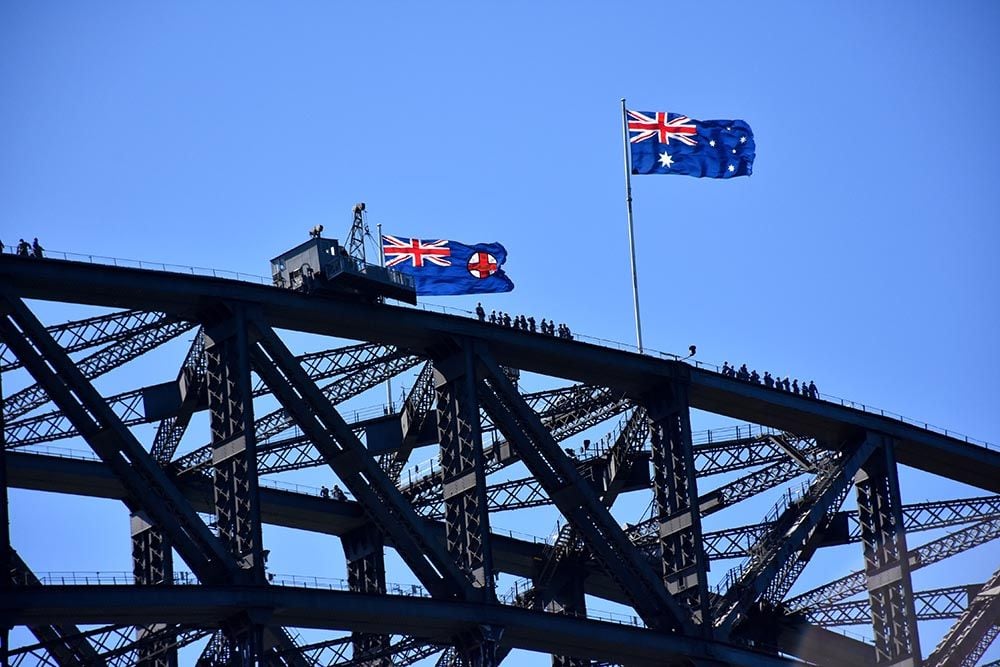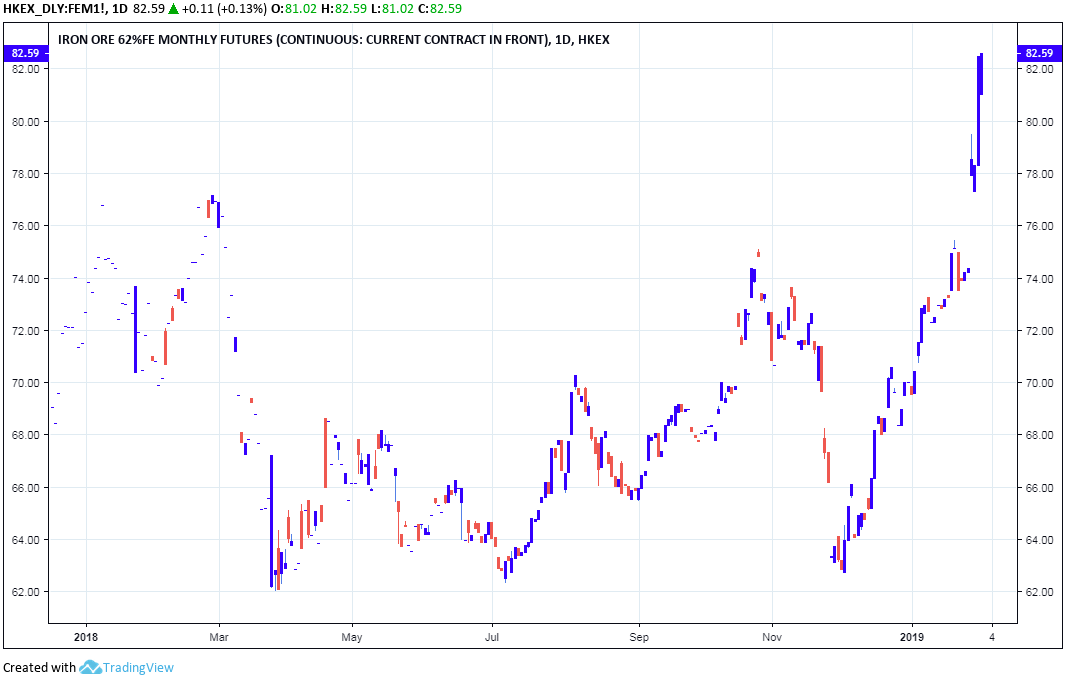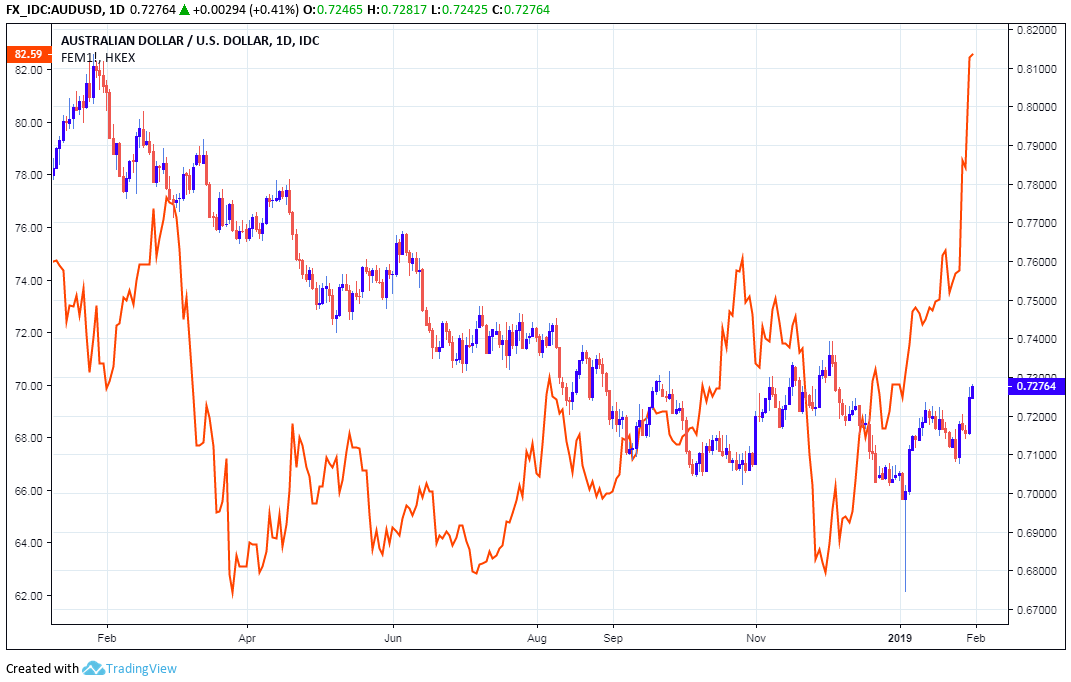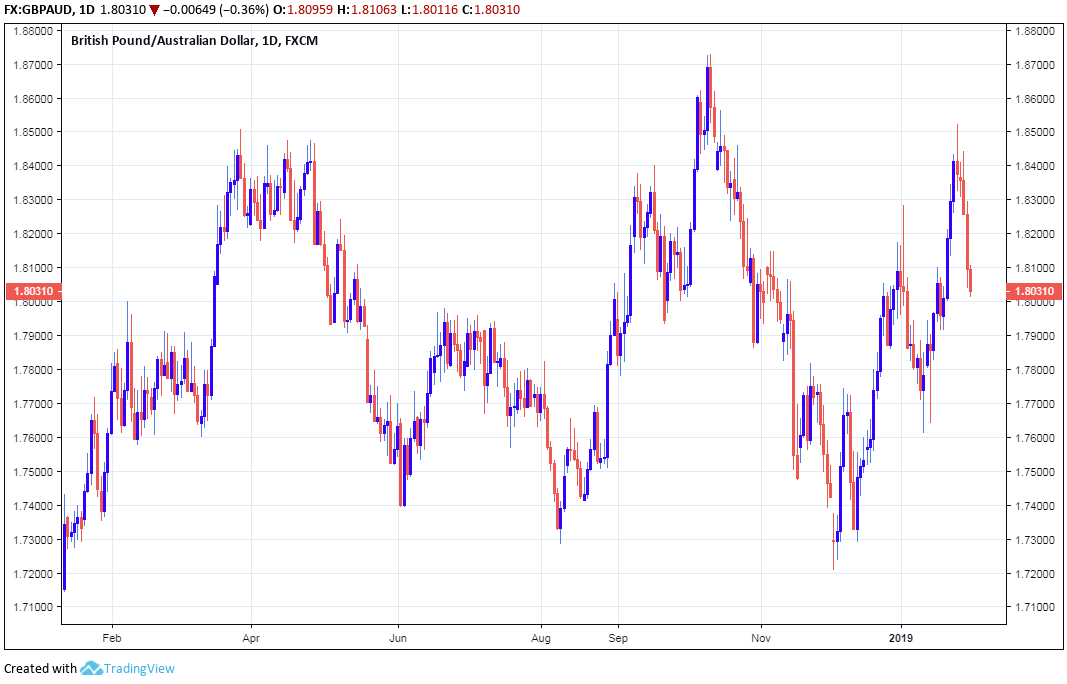The Australian Dollar Rises Through G10 League Table as Stars Align for Recovery
- Written by: James Skinner

Image © Desiree Caplas, Adobe Stock
- AUD rises through G10 league table as stars align for a recovery.
- Aided by iron ore, Fed retreat, resilient inflation, trade war progress.
- "Under-valued, high-yielding commodity currencies" are hot says ING.
The Australian Dollar rose to become the second best performing G10 currency of 2019 on Thursday as its economic and financial stars continued conspiring to engineer a more protracted recovery for the Antipodean unit.
A sharp rise in iron ore futures prices are without doubt the most significant contributor to this week's gains by the Australian Dollar, although signs of that a deal to end the U.S.-China trade war is in the pipeline, resilient domestic inflation figures and an interest rate capitulation by the Federal Reserve (Fed) have also been at play too.
Iron ore futures prices rose sharply overnight on most exchanges after Brazilian mining firm Vale said it will decommission 10 mining dams in response to a tragic disaster at one of its domestic sites earlier this month.
That could see more than 40 million tonnes of iron ore taken off the market each year, which is equivalent to around 2.5% of the world's seaborne iron ore trade, according to Commonwealth Bank of Australia (CBA) estimates.
"Vale's plan to boost production from existing mines may face resistance from regulators, adding delays to Vale's production plans. We could see iron ore remain above US$80/t until Vale's production outlook becomes clear," says Vivek Dhar, a mining and commodities strategist at Commonwealth Bank.

Above: Iron Ore futures price, Honk Kong Stock Exchange.
Australia is by far the world's largest producer of iron ore and the ferrous metal is the single most important item in the nation's export basket so changes in prices matter for both economic growth as well as the exchange rate.
The Aussie is effectively underwritten by the nation's mammoth iron ore and other commity trade with China. And futures prices have now risen by almost 20% for the 2019 year-to-date as markets are increasingly anticipating that the tragedy in Brazil will cause supply headwinds.
This increase in prices will, if maintained, lift the "terms of trade" during the months ahead and demand an appreciation of the Australian Dollar. It could also support a pick-up in Aussie economic growth.
"A rise in the terms of trade means that incomes have lifted in the quarter, all else being equal, and argues for an appreciation in AUD. See here for details. Technically, AUD/USD needs to sustain a break above its 200‑day moving average at 0.7393 to gain upside momentum," says Elias Haddad, a currency strategist at CBA.

Above: AUD/USD rate alongside HKEX iron ore futures price (orange).
The AUD/USD rate was quoted 0.35% higher at 0.7279 Thursday and is now up 3.25% thus far in 2019, making it the second best performing G10 currency this year now that it's eclipsed Pound Sterling.
The Pound-to-Australian-Dollar rate was quoted -0.33% lower at 1.8022 and is now carrying a fractional loss for the year-to-date, while the Canadian Dollar still leads the G10 pack in the league table of best performers.
"The USD was sold heavily after the FOMC altered its guidance this morning. In the near term this momentum will likely be maintained and the AUD will push higher," says Jack Chambers, an interest rate strategist at Australia & New Zealand Banking Group (ANZ).
Australia's Dollar fell by around 9% in 2018 as the domestic interest rate outlook darkened and then the U.S. and China engaged in a tariff fight that is yet to be resolved, prompting fears for the global as well as Australian economies.
However, the Aussie's economic and financial stars have begun to align for a recovery this week and the rise in iron ore prices is just one factor contributing to the improved fortune.
"High yield activity/commodity currencies have been the top performers in both the G10 and EM spaces so far this year – benefiting from the reprieve from Fed tightening and the truce in the China trade war. The Renminbi has also recovered about of a third of last year’s losses against a basket of currencies," says Chris Turner, head of currency strategy at ING Group.

Above: Pound-to-Aussie rate shown at daily intervals.
Thursday's price action comes after Federal Reserve officials held U.S. interest rates at 2.5% Wednesday and said in the statement accompanying the decision that they aren't yet sure they'll even need to raise rates at all this year.
Previously the Fed had said that "further gradual increases" in interest rates would be required to prevent inflation from rising meaningfully above the 2% target, which was a staple line that has appeared in almost all policy statements during the last three years or more.
But the Fed abandoned that judgement on Wednesday and is now simply going to be "patient" while it waits for U.S. and global economic developments to dictate whether any further rate rises are going to be necessary over the coming quarters.
"Given overweight positions in the US late last year and under-invested positions of the buy-side currently, we suspect investors will continue to cautiously put money to work in under-valued high yield currencies. They will do this until they see clear signs of a re-escalation in trade tensions (US tariffs on auto imports could be a story mid February) or there are other signs of a hard landing. This then should mainly be a story of USD weakness," says Turner.
The Fed's shifting stance could easily pull the proverbial rug out from under the U.S. Dollar this year, providing the Aussie with respite from some of the bond market pressures that helped force it close to a double digit loss in 2018.
The Reserve Bank of Australia (RBA) has held its rate at a record low of 1.5% for over two years now, citing below-target inflation and an economic outlook that is not sufficient enough for it to support a sustainable return of the consumer price index to within the 2%-to-3% target band in the short-term.
Given that U.S. interest rates reached 2.5% last year, bond market yields have long provided incentive for investors to sell or avoid the Antipodean currency, and to buy the U.S. Dollar instead. Similar dynamics have been in play with other exchange rates.
"Our economists note that they are reassessing their rate views, which are currently flat against a market with 13bp of cuts priced in this year," says Adam Cole, chief currency strategists at RBC Capital Markets.
An increasingly downbeat inflation outlook, a wobbling housing market and concerns related to the U.S.-China trade war have seen the market begin betting heavily that the RBA will soon cut its interest rate to a fresh record low.
That has, since September last year, weighed increasingly on the Aussie. But data released Wednesday showed Australian inflation pressures were surpisingly resilient in the fourth quarter. And with iron ore prices now on the rebound, it might not take much to have the market bail on its bets against the Australian central bank and currency.
If U.S. and Chinese negotiators are able to seal a deal to end the trade war before the March 01 deadline, a more protracted recovery could then be as good as a done deal for the Australian Dollar.
Time to move your money? Get 3-5% more currency than your bank would offer by using the services of foreign exchange specialists at RationalFX. A specialist broker can deliver you an exchange rate closer to the real market rate, thereby saving you substantial quantities of currency. Find out more here.





